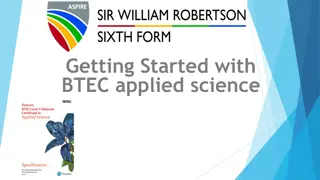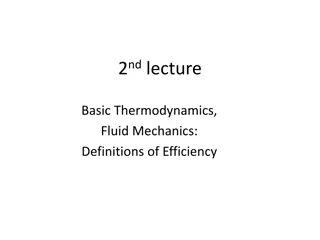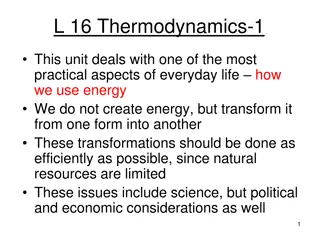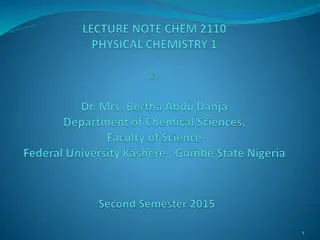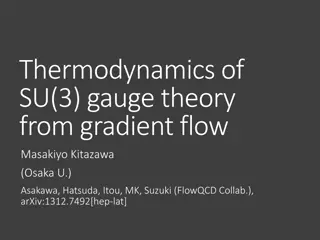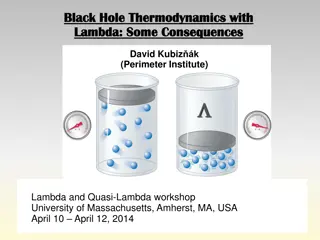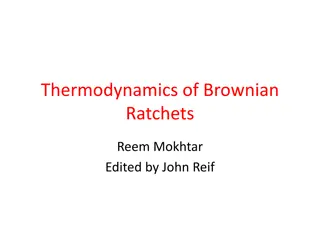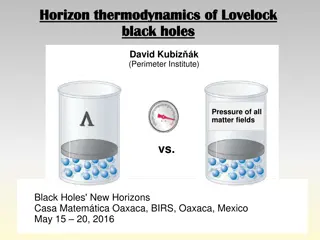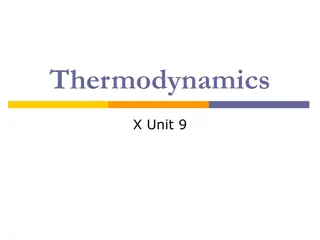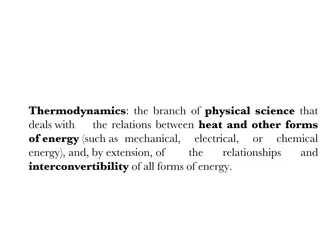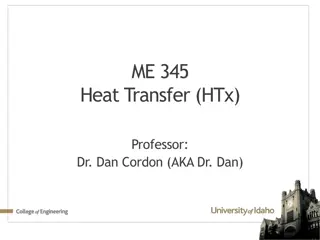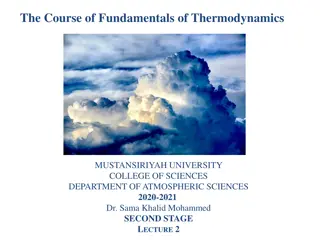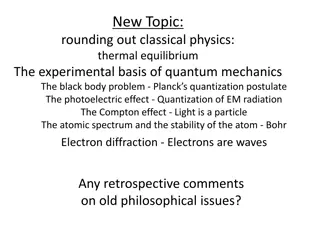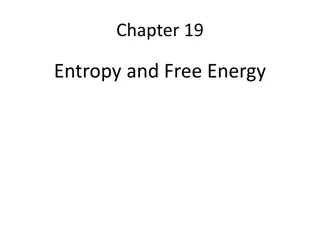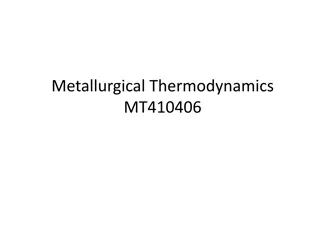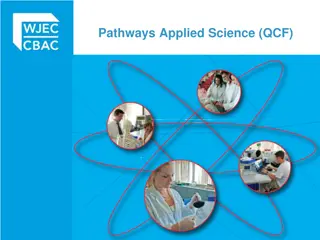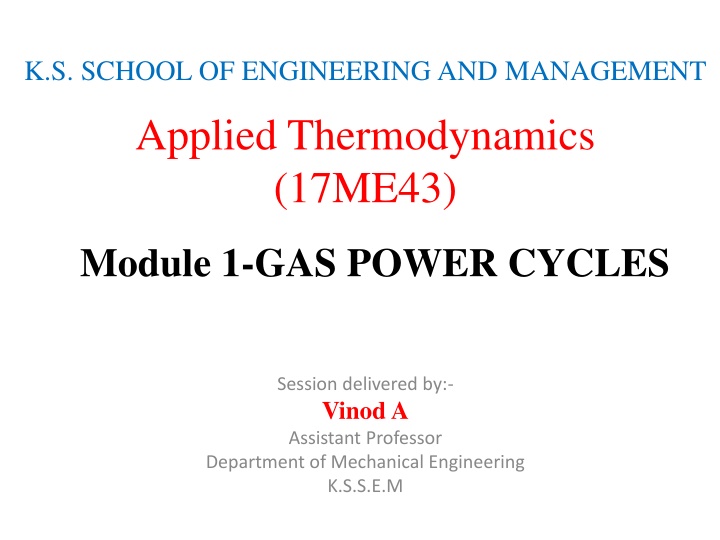
Applied Thermodynamics (17ME43)
Learn about gas power cycles, including ideal and actual cycles, applications of thermodynamics in power generation and refrigeration, air standard cycles, assumptions in air standard cycles, and specifics of Carnot cycle. Explore the key points to remember and fundamental processes involved in these cycles.
Download Presentation

Please find below an Image/Link to download the presentation.
The content on the website is provided AS IS for your information and personal use only. It may not be sold, licensed, or shared on other websites without obtaining consent from the author. If you encounter any issues during the download, it is possible that the publisher has removed the file from their server.
You are allowed to download the files provided on this website for personal or commercial use, subject to the condition that they are used lawfully. All files are the property of their respective owners.
The content on the website is provided AS IS for your information and personal use only. It may not be sold, licensed, or shared on other websites without obtaining consent from the author.
E N D
Presentation Transcript
K.S. SCHOOL OF ENGINEERING AND MANAGEMENT Applied Thermodynamics (17ME43) Module 1-GAS POWER CYCLES Session delivered by:- Vinod A Assistant Professor Department of Mechanical Engineering K.S.S.E.M
Introduction A cycle is defined as a repeated series of operations occurring in a certain order. If the cycle is of a imaginary perfect engine, then the cycle is called as Ideal Cycle. If the cycle is of the actual engine, then the cycle is called as Actual cycle.
Two important Applications of the Thermodynamics are : Power Generation Refrigeration Both are accomplished by systems that operate on a Thermodynamic Cycle. It can be categorized as Gas cycles and Vapor cycles In Gas cycles, the working fluid remains in gaseous phase throughout the entire cycle. In Vapor cycles, the working fluid exists in vapor phase during one part of the cycle and in liquid phase in another part.
Air standard cycles Carnot cycle Otto cycle Diesel cycle Dual cycle Stirling cycle Ericsson cycle Atkinson cycle (over expanding cycle)
Important Points to remember on Air standard cycles The ratio of the area enclosed by the cyclic curve to the area under heat-addition process curve represents the Thermal Efficiency. On both the P-v and T-s diagrams, the area enclosed by the process curves of a cycle represents the net work produced during the cycle (also equivalent to the net heat transfer)
Assumptions in Air Standard Cycles The working fluid is Air which continuously circulates in a closed loop and always behaves as an Ideal gas. All the processes in the cycle are internally reversible. The combustion process is replaced by heat addition process and the exhaust process is replaced by heat rejection process. The specific heat of the gas remains constant. i.e., cp = 1.005 kJ/kg-K and cv = 0.718 kJ/kg-K R = cp cv = 0.287 kJ/kg-K for Air
Carnot cycle Process 1-2: Isothermal Expansion (heat addition) Process 2-3: Isentropic Expansion Process 3-4: Isothermal Compression (heat rejection) Process 4-1: Isentropic Compression ???????=?? ?? ?? Note: For further details, refer the below link https://www.youtube.com/watch?v=77EIce2Nu8Y
Effect of compression ratio (rc) on Otto cycle The efficiency of the Otto cycle is given by 1 ?????= 1 (??)? 1 It is clear that the efficiency of the Otto cycle depends on the compression ratio rc. When high compression ratios are used, the temperature of the air-fuel mixture rises above the auto-ignition temperature of the fuel(the temperature at which the fuel ignites without the help of spark) during combustion. This leads to Engine Knock and reduces the performance causing an engine damage.
Diesel cycle Process 1-2: Isentropic Compression Process 2-1: Isobaric heat addition (constant pressure heat addition) Process 3-4: Isentropic expansion Process 4-1: Isochoric heat rejection (constant volume heat rejection) ?? 1 ? ? 1 1 ???????= 1 (??)? 1 Note: For further details, refer the below link https://www.youtube.com/watch?v=DLzM-PEwTXg
Dual cycle (Limited pressure cycle) Note: In this cycle, the heat addition occurs in two steps: Process 2-3 and Process 3-4 Process 1-2: Isentropic compression Process 2-3: Constant volume heat addition Process 3-4: Constant pressure heat addition Process 4-5: Isentropic expansion Process 5-1: Constant Volume heat rejection ???? 1 1 ?????= 1 (??)? 1 ?? 1 + ??? ? 1
Stirling cycle Concept of Regeneration transferred back to the working fluid in another part of the cycle Regeneration is a process during which heat is transferred to a thermal energy storage device (called regenerator) during one part of the cycle and is
Continued ?????????=?? ?? ??
Comparison of Otto, Diesel and Dual cycles Following are the important factors which are used as the basis for comparison of the cycles: 1. Compression ratio 2. Maximum pressure 3. Heat supplied 4. Heat rejected 5. Net work
Continued 1. For the same compression ratio and same heat input
Continued 2. For the same maximum pressure and Heat input Otto cycle: 1-2-3-4-1 Dual cycle: 1-2 -3 -4-1 Diesel cycle: 1-2 -3-4-1
Gas turbines Brayton cycle Description and analysis Methods to improve the thermal efficiency of the cycle Regenerative gas turbine cycle Intercooling and reheating in gas turbine cycle
Turbine A turbine is a device in which work is developed as a result of a gas or liquid passing through a set of blades attached to a shaft free to rotate.
Brayton cycle Gas turbines usually operate on an Open cycle as shown in the figure. Fresh air at ambient conditions is drawn into the compressor, temperature and pressure are raised. The high pressure air proceeds into the combustion chamber, where the fuel is burned at constant pressure. The resulting high-temperature then enter the turbine, where they expand to the atmospheric producing power. The exhaust gases leaving the turbine are thrown out, causing the cycle to be classified as an open cycle where its Fig: Open cycle gas turbine engine pressure while
Continued The open cycle discussed previously, can be modeled as closed cycle (for analysis) as shown in the figure below. Here, expansion remains the same where as the combustion process is replaced by a constant pressure heat addition process from an external source and the exhaust process is replaced by a constant pressure heat rejection process to the ambient air . the compression and The ideal cycle that the working fluid undergoes in this closed loop is the Brayton cycle.
Effect of pressure ratio on the performance of gas-turbine cycle 1 ????????= 1 ? 1 ? The thermal efficiency of an ideal Brayton cycle depends on the pressure ratio of the gas turbines and the specific heat ratio of the working fluid. The highest temperature in the cycle occurs at the end of the combustion process (state 3), and it is limited by maximum temperature that the turbine blades can withstand. ?? This also limits the pressure ratios that can be used in the cycle.
Effect of pressure ratio for Fixed temperature ratio on thermal efficiency The pressure ratio on the effective area of the cycle (rp = 8.2) is more than the area of the cycle (rp = 2). But as pressure ratio increases (rp = 15), the area decreases and the work output of the cycle also decreases and thus the cycle efficiency decreases. Therefore, in a gas turbine power plant, there should compromise between pressure ratio and work output be a the
Deviation of Actual Gas-Turbine cycle from the Idealized ones The actual gas-turbine cycle differs from the ideal Brayton cycle on several accounts. Some pressure drop is inevitable during heat addition and heat rejection processes. More importantly, the actual work input to the compressor is more, and the actual work output from the turbine is less irreversibilities. ?=??????????? ??????? = 2? 1 2? 1 because of ??????? ??????????? = 3 4? 3 4? ?=
Back work In gas turbine plants, the ratio of the compressor work to the turbine is very high. Usually more than 50% of the turbine work output is used to drive the compressor. If the isentropic efficiencies of the compressor and turbine are low, the situation is even worse.
Methods to improve Thermal efficiency of the gas turbines Increasing the turbine inlet temperatures. Increase the efficiencies of turbo machinery components. Adding modifications to the basic cycle Regeneration Reheating Intercooling
The Brayton cycle with Regeneration qregen, act = h5 h2 qregen, max = (h5 h2)= (h4 h2) ??????,??? ??????,??? = 5 2 4 2 =?5 ?2 ?4 ?2 ? =
Gas turbines with Reheat Since, the constant pressure on a T-s diagram diverge slightly with increasing entropy, the total work of the two-stage turbine is greater than that of a single expansion from state 3 to state 4 . Thus net work for the reheat cycle is greater than that of the cycle without reheat. Despite the increase in net work with reheat, the cycle thermal efficiency would not necessarily increase because a greater total heat addition would be required.
Brayton cycle with Regenerator, Reheating and Intercooling


